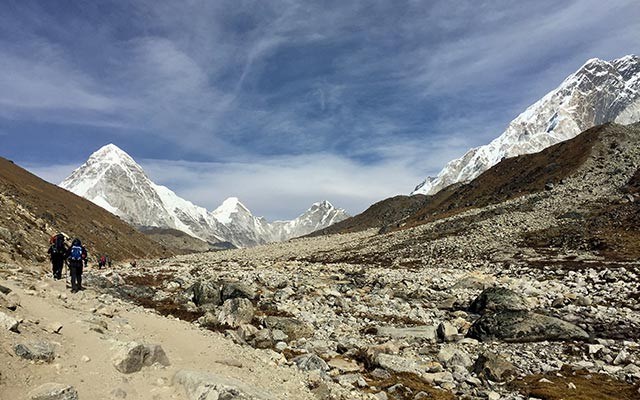In the Himalayan aerie of Tengboche, en route to Everest Base Camp (EBC), we visit its venerable monastery. Built in 1913, destroyed by a 1934 earthquake, rebuilt, lost to fire in 1989 and rebuilt again, it's famous in climbing lore. Before it opens at 3 p.m., trekkers gather outside the main door, bolted shut with medieval overkill. Eventually, a shuttered window opens above and a monk trumpets the call to prayer with a giant conch shell — very National Geographic.
Inside, across a courtyard, a dozen of us enter, removing boots to sit against cold stone while three monks chant sutras. It's pure sound, the chants braiding like rope, projected into frigid, incense-filled air that condenses our breath. We sit on toques, coats wrapped around bare feet, watching candles flicker and scanning walls painted with Buddhist scenes illuminated by streaks of sunlight sloping in from narrow windows. Inside our heads, each finds their own meaning.
Next morning ice crisscrosses the trail as we descend through magical rhododendron forest before climbing toward Shomare for lunch. Later, when the paths diverge like the river they follow, we choose the passage to 4,300-metre Dingboche, a town of low buildings and stone corrals where we'll take another acclimatization day.
They say everyone gets a cold on this trek. Check. They also say everyone gets gut problems. Check. Add in pulled muscles and altitude headaches and I'm fighting, while travel companion Asta remains a picture of vitality. Two days later I'm still dragging when we start the last long climb from Dhukla. Despite beauty that makes you gasp, it now feels like a chore, and misery makes me wonder why we chose this trek instead of an easier one.
The answer lies on 4,830-metre Thokla Pass, where a stone gate strung in prayer flags opens on an area constellated with memorials to those who've died on Everest. I'm not prepared for the powerful emotion that grips me. A lump forms and my eyes mist over. I know these people. Reading books on Everest since I was a kid, the stories represented by these stone piles are familiar; in some cases — as with those who perished in the 1996 debacle immortalized in Jon Krakauer's Into Thin Air — the intimate details of their last moments. Here stands a singular crucible to human endeavour — all the good, bad, and ugly reasons people attempt to summit the world's highest peak, a proxy, whether we believe so or not, of our own myriad conquests. On this lofty, lonely pass all come together in eternity to create a strong spirituality and sense of community. Coming upon this place I'd never dreamed of being casts my own pedestrian effort as similar pilgrimage, galvanizing that all on this trail are equally engaged.
Solemn, we press on, angling down to the Khumbu Valley. In the distance a yak train moves beside the river between enormous moraines, Pumori's pyramidal peak floating behind. Soon we're in Lobuche, a clutch of crumbling guesthouses huddled beneath Nuptse's sheer south face. In the courtyard of our hotel, parabolic sun-dishes boil huge kettles of water. Though a sign inside reminds guests that they do their best at 5,000 metres without electricity or running water, the putrid, frozen bathroom is rank enough to be awarded "worst loo" of the trip.
Next morning, wearing everything we own, we follow what's left of the Khumbu Glacier, broken and buried in the rubble it once carried. After only a few hours tiny Gorak Shep appears around a corner, two lodges beside a dried lake bottom — the old basecamp site from the days of Hilary. Though it's only 10:30 a.m., we eat. The plan is to trek 1.5 hours to the current EBC and then climb Kalla Pathar hill for sunset. Weakening, I elect to climb Kalla Pathar now with guide Nowa, and skip the Everest Base Camp walk that Asta and Norbu Sherpa immediately undertake. "Hill" is a misnomer for the steep and relentless two-hour climb to a dizzying 5,550 metres, and it's windy and cold to boot. But the views are spectacular — Pumori, Nuptse, Lhotse and the dark wedge we've come to pay homage, Everest, which offers fleeting glimpses as weather swirls the summit.
Below, around EBC, black dots swarm the dwindling Khumbu ice and I wonder what Asta and Norbu are seeing. We spend only 10 minutes on top as Nowa is miserable with altitude. Though it takes but an hour to descend I'm wiped. Unresponsive, uninterested in food, I can't get warm despite lying in my sleeping bag swathed in down clothing for an hour. Only later do I spontaneously wake from this walking coma to enjoy the yak-dung warmth of the lodge.
Oddly, that night is my best sleep of the trip — perhaps because I now know why I'm here, and there's nothing left to worry about. After all the struggle, I'd beheld our mute goal while it beheld back, seeing nothing, saying everything.
This is the fourth in the series about Leslie's trip to Everest. For the previous columns go to www.piquenewsmagazine.com
Leslie Anthony is a Whistler-based author, editor, biologist and bon vivant who has never met a mountain he didn't like.




